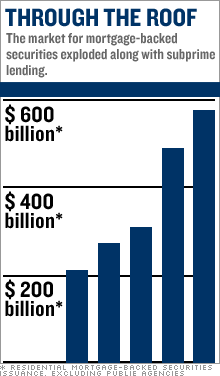Hier der Artikel aus "Fortune" von obgicou aus dem letzten Posting. Hab ihn mal ganz reingestellt, weil es sehr gut erklärt, was es mit ABS und CDO auf sich hat.
Interessant ist der Artikel auch deshalb, weil es hier nicht um Aktien-, sondern um Bond-Risiken geht: Scheinbar sichere Anleihen, die durch Hypotheken besichert sind (ABS und CDO) und die bei den Kreditagenturen wie Moody's "gute" Ratings haben, könnten infolge der Pleitewelle im Subprime-Sektor dennoch stark fallen. Bei den dann folgenden Rating-Downgrades dieser Bonds droht eine Abwärtsspirale: Versicherer und Pensionskassen, die diese Bonds wegen ihrer hohen Renditen massenhaft in ihren Depots haben, MÜSSEN sie verkaufen, wenn das Rating unter BBB fällt (vertragliche Verpflichtung). Das entzieht dem Markt dringend benötigte Liquidität - mit der Folge, dass die Haus-Preise weiter fallen. Dann fallen aber auch die Bonds weiter - ein Teufelskreis.
The dangers of investing in subprime debt
Fortune's Bethany McLean explains how the credit-rating agencies got in the middle of the subprime-lending crisis.
FORTUNE Magazine
By Bethany McLean, Fortune editor-at-large
March 19 2007: 9:22 AM EDT
(Fortune Magazine) -- Amid the chaos of the escalating subprime mortgage crisis, the three major credit-rating agencies - Fitch, Moody's and Standard & Poor's - have been voices of calm. They've downgraded only a sliver of the debt backed by such mortgages, and they say they expect the mess to stay safely confined to the subprime sector.
But what if they're wrong? It's not just their reputations, already tarnished by their failure to give investors timely warning of the Enron or WorldCom implosions, that are at stake, but possibly the housing market itself.
To appreciate the role that the rating agencies play in today's housing market, you have to understand a piece of Wall Street alchemy: the process by which mortgages are combined, carved up, recombined and carved up again in almost endless permutations to create new forms of debt (which usually go by three-letter abbreviations).
A bank or brokerage bundles up hundreds of mortgages and sells investors debt that is backed by mortgage payments and secured with homes. These asset-backed securities - ABS's, in Street parlance - are sold in slices, each of which carries its own theoretical level of risk, ranging from the supposedly invulnerable (AAA) all the way down to the bottom rung of investment grade and even past that, to a highly speculative unrated slice.
It's possible to create a AAA-rated asset out of somewhat shaky collateral, because the first dollar of income goes to the securities with the highest rating, while the first dollar of loss is assigned to those with the lowest. The bottom layers provide a cushion that supposedly protects the higher-rated securities.
Lately much of the bottom rung of investment-grade ABS's has been snapped up by another Street creation called a collateralized debt obligation (CDO), which, like an ABS, is sold in slices. A large chunk of a CDO that consists of barely investment-grade securities can still secure a coveted AAA rating - again, because any losses have to eat through the bottom layers.
These products exploded in popularity in recent years because investors - including pension funds and insurance companies, which must mostly buy investment-grade-rated debt - had a voracious appetite for them. That in turn encouraged a historic increase in subprime lending.
The amount of subprime mortgages issued shot up from $35 billion in 1994 to $625 billion in 2005 (Chart unten), says Josh Rosner, a managing director at research firm Graham Fisher. Brokerage firms, which packaged, sold and traded these creative instruments, made big profits. And so did the credit-rating agencies. At Moody's (Charts) (the only one publicly traded), net income went from $159 million in 2000 to $705 million in 2006, in large part because of increases in fees from "structured finance," the umbrella under which this mortgage alchemy falls.
Today all the rating agencies say they have scrubbed the numbers, and slices of debt that are rated investment grade will mostly stay that way, even if the collateral consists of subprime mortgages.
Critics have their doubts. A paper co-authored by Rosner and Joseph Mason, a visiting scholar at the FDIC, argues that if home prices depreciate, even investment-grade CDOs will suffer "significant losses."
Janet Tavakoli, who runs Tavakoli Structured Finance, points out that AA-rated tranches of CDOs backed by subprime mortgage paper now yield far more than AA-rated debt backed by other assets - a sign that the market doesn't trust the ratings. "No one believes the ratings have any value," she says. Opined Grant's Interest Rate Observer: "We are willing to bet that the agencies assigned too little weight to greed, ignorance, and soft criminality."
All this has real-world implications. If the rating agencies do downgrade some of this paper, investors who can't own non-investment-grade debt would be forced to sell in droves. The losses could affect the bottom line of an untold number of companies, including insurers and possibly even mutual funds.
And if CDOs stop purchasing mortgage paper, then a major source of liquidity will evaporate. That tightening of credit could affect the demand for homes, thereby turning the virtuous circle of recent years into a vicious one of falling home prices. That, say Rosner and Mason, creates the "potential for prolonged economic difficulties that also interfere with home ownership in the U.S." And who will take credit for that?
|
Angehängte Grafik:
through_roof_chart.gif
